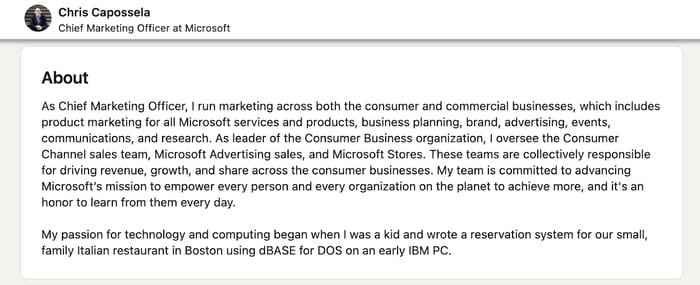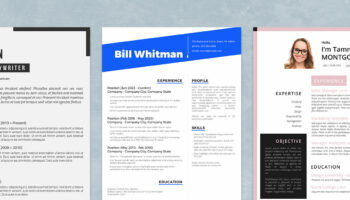When you sit down to write your resume, your brain starts bombarding you with questions.
Which resume format should I use? How to style my header area? Should my resume be in the past tense?
We answered the first two in earlier posts — and now want to chime in on the endless debate: resume present or past tense?
What Tense Should a Resume Be In?
Because a resume offers a summary of your work experiences, it should be written in the past tense. Stylistically, it is correct to use past simple for describing your past duties and accomplishments in the work experience section, education, and professional resume summary (if you choose to have one). You can, however, use present tense for describing your current role, plus listing general details about the company.
To give you a better idea, here’s how a some of your resume bullet points might look:
Region Sales Manager
Acme Corp, NYC, NY
May 2020-June 2021
- Led a sales team of 3 regional managers, covering the East Coast Market
- Cultivated a client list of 100+ local manufacturing companies
- Increased monthly company product sales by 50% in 2020.
OK, But Why are Some Resumes Written in Present Tense?
Using present tense for your current job entry isn’t a faux pas. Likewise, you can use the present simple tense in a professional bio or resume summary section.
As Purdue University guide rightfully notes
Verbs should be present tense for jobs you currently hold: Run point of sales register. An exception to this is using a verb for something that happened in the past at your current job (from the example above: Won “Employee of the Month” May 2006, April 2008).
The key, however, is to have tense consistency within the same work entries to avoid confusing the reader.
For example, in a teacher resume you might style your work experience entry the following way:
Adjunct Arts Instructor 01/05/2018 – present
Sunnydale Community College, Wales MI
- Deliver lectures on contemporary US art to bachelor students
- Host practical watercolor workshops for part-time students
- Organized an on-campus Pop Art Exhibition together with Sunnydale Gallery
- Participated in developing “America Arts History: The Present” together with academic staff
As you can see from this sample, the work entry uses both present and past tenses. In this case, using the present tense indicates the person’s current duties. Past tense, in turn, is used to describe on-the-job accomplishments and completed projects.
You can check more resume samples on our website to get a better sense of how to balance different tenses.
Should a Resume be Written in First Person?
This is a follow-up question many people have in connection to the resume tense. Yes, your resume should always be in first-person (not third). The caveat, however, is that you should omit the “I” pronoun — and instead imply it in your writing. This is called the “first-person implied” writing style.
Using first-person implied in resume writing is easy to do. Structure a sentence as you normally would when describing yourself. Then remove the personal pronouns like “I”, “me”, and “my”.
Here are several quick examples for resume entries in present and tenses.
For present job:
- First-person: I created a new homepage design.
- First-person implied: Created new homepage design.
For past jobs:
- First-person: My average CSAT was 98%
- First-person implied: Maintained average CSAT of 98%
You should also use first-person implied for writing a resume summary — a quick snippet of your main skills, sitting atop of your resume. For example, for your product manager resume, you should style your summary the following way:
B2B SaaS product manager with significant experience in ecommerce and project management industries and a background in UX. Team player with strong emotional intelligence skills who loves to apply design thinking principles to bring in-demand product features to the market.
Should I Strip Away All Personal Pronouns?
No, in some cases, keeping “my”, “I”, and “me” pronouns is fine, especially if you struggle to convey an idea without them. When writing your resume, clarity is your first priority. If you can’t describe your line of work without throwing in a couple of personal pronouns, it’s fine. No one will hold this fact against you.
What Tense and Pronouns Should I Use for My LinkedIn Profile?
If you also want to optimize your LinkedIn profile for extra impact, use the same logic as for your resume:
- Present tense for LinkedIn summary + current position
- Past tense for other work experiences + accomplishments
As for pronouns: LinkedIn is a social media network, so it’s fine to be more colloquial and use “I” when speaking of yourself in your LinkedIn profile summary. Think of it this way: when you professionally introduce yourself in person, you don’t speak of yourself in the third person or use the first-person implied. That would be weird, right?
LinkedIn is a platform for online introductions, so treat it as such! Make your profile sound human and personified. That’s the tone even season execs adopt like Karen S. Lynch, CEO of CVS Health, or Chris Capossela, CMO of Microsft.

Source: LinkedIn
Final Thoughts
Now you know what tense to use in your resume for past experiences and for current positions. So you are out of excuses for procrastinating. Go grab yourself a professional resume template and start putting words on the page.






